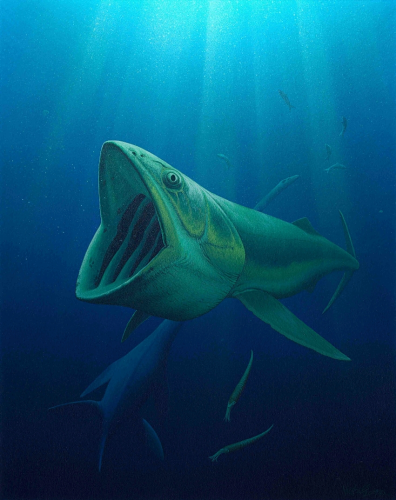Feb 18, 2010
DePaul Professor’s Find Helps Document Plankton-Eating Giant Fish That Roamed Earth’s Seas During Dinosaur Era
DePaul Professor’s Find Helps Document Plankton-Eating Giant Fish That Roamed Earth’s Seas During Dinosaur Era
Recently analyzed fossil evidence shows for the first time that giant plankton-eating fish lurked prehistoric seas for more than 100 million years before they became extinct at the same time as the dinosaurs.
In the Feb. 19 issue of the journal Science, Kenshu Shimada, associate professor of environmental and biological science at DePaul University, and an international research team describes how fossils from Asia, Europe and the United States reveal a previously unknown dynasty of giant plankton-eating bony fish that filled the seas of the dinosaur era 66 million to 172 million years ago. The study is expected to rewrite the history of ocean’s ecosystems in the world’s geology and marine ecology textbooks.
The fish, estimated to be nearly 20 feet in length, possessed narrow toothless jaws that supported a gaping mouth as well as long, gill-supporting bones, all of which were necessary to filter out enormous quantities of tiny plankton. The team named this fish Bonnerichthys, in honor of the family in
Interestingly, the ancestors of modern groups of large plankton-eaters–such as whale sharks, manta rays and baleen whales–emerged or became prominent only after the extinction of Bonnerichthys and its relatives, indicating that modern-day plankton-eaters evolved to fill the ecological niche left behind by these dinosaur-aged plankton-feeders.
“A variety of plankton had evolved by the middle of the dinosaur era, so it was a long-standing scientific mystery as to why almost no large vertebrates were feeding on these abundant resources in ancient seas,” said Shimada, who also serves as research associate at the Sternberg Museum of Natural History in Kansas. “Our study demonstrates that giant plankton-eaters were thriving through more than half of the dinosaur era spanning over 100 million years, which is much longer than any lineages of modern plankton-feeding giants.”
The team effort emerged in 2007 when two
Similar giant plankton-eating fish were known to have existed for only 20 million years in
Luck also played a role in the breakthrough. Shimada, who through happenstance at the age of 15 learned of an important specimen from Asia and studied the fish from the
In addition to Friedman and Shimada, the report’s authors were Larry D. Martin of University of Kansas, Michael Everhart of the Sternberg Museum of Natural History, Jeff Liston of the University of Glasgow, and Anthony Maltese and Michael Triebold of Triebold Paleontology, and the Rocky Mountain Dinosaur Resource Center, Colorado.

DePaul Prof. Shimada Helped Document Ancient Giant Fish
